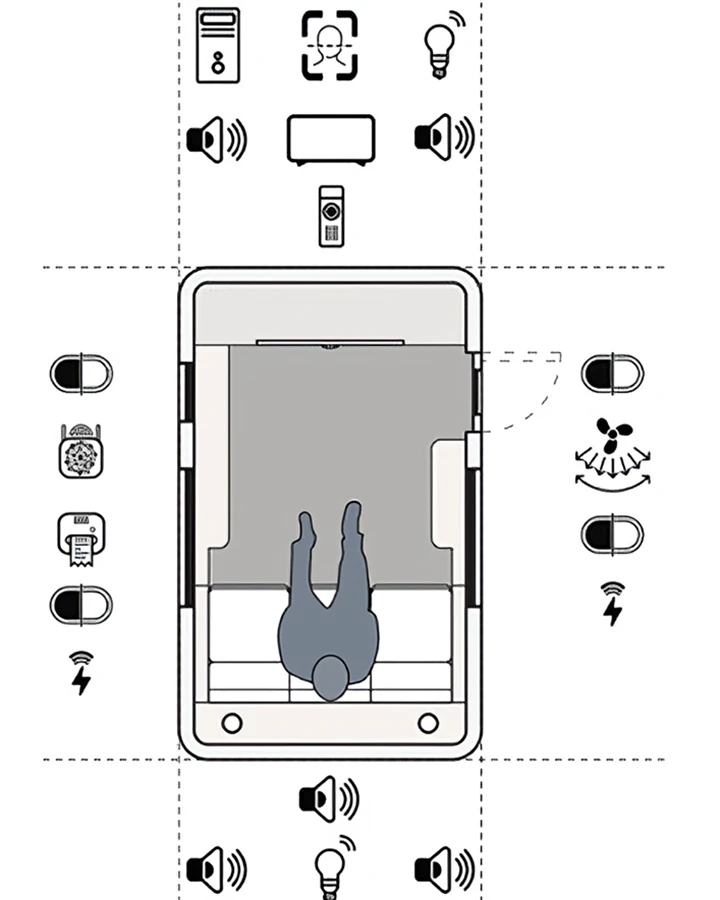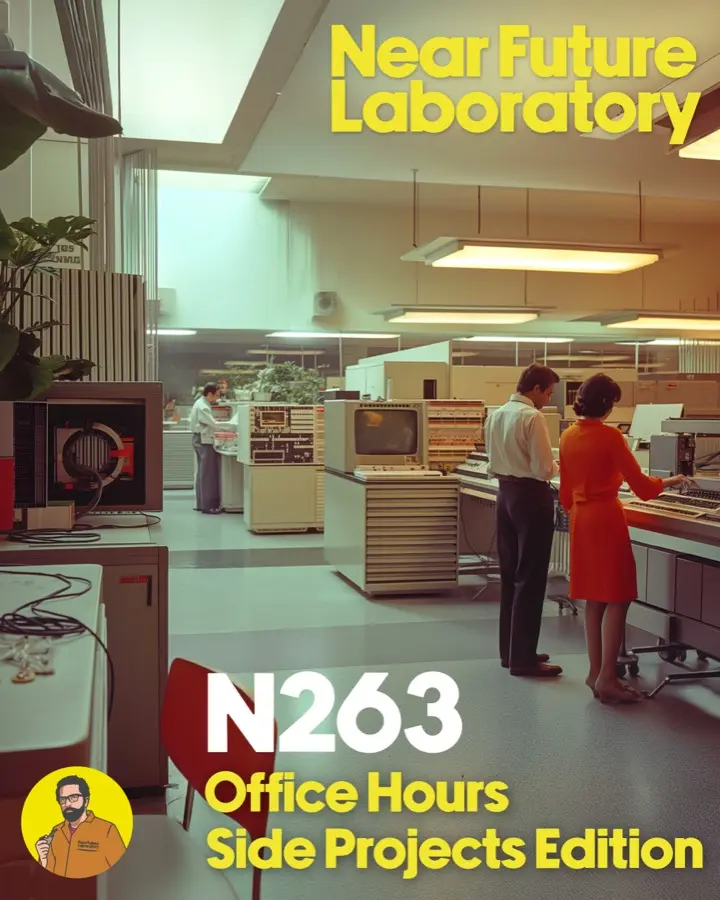Near Future Laboratory Blog
Thoughts, Reflections, Updates & Week Notes
Jun 8, 2025 – Jul 2, 2025
w24/w25/w26/w27/ 
Jul 02, 2025
“At the heart of the EFM is a mundane scenic event: watching TV.”
Here's that paper by Paul Coulton, et.al. that describes how a fictional, AI-driven “smart media” experience was staged inside a mobile living room (a retrofitted tear-drop caravan), where participants engaged with what appeared to be an intelligent TV system that was configured to adapt in real time to their behavior. But actually, the entire experience was carefully orchestrated using the "Wizard of Oz" type setup. They did this to simulate an AI-driven environment and then observe how people react when the basic norms of familiar and mundane activities, like watching TV, are subtly disrupted.
Here's that paper by Paul Coulton, et.al. that describes how a fictional, AI-driven “smart media” experience was staged inside a mobile living room (a retrofitted tear-drop caravan), where participants engaged with what appeared to be an intelligent TV system that was configured to adapt in real time to their behavior. But actually, the entire experience was carefully orchestrated using the "Wizard of Oz" type setup. They did this to simulate an AI-driven environment and then observe how people react when the basic norms of familiar and mundane activities, like watching TV, are subtly disrupted.
future mundanedesign fictionexperiential futuresartificial intelligenceprototypingspeculative designspeculative futures

Jun 28, 2025
Join me on June 28th at 3pm at the LA Design Festival for a hands-on introduction to futuring through Design Fiction.
Sign up to attend here.
In this compact workshop, you'll explore how to prototype possible futures using artifacts rather than predictions. We’ll step beyond traditional storytelling to create tangible glimpses into what could be—using props, products, and everyday ephemera from worlds just around the corner.
Come and stretch your imagination with us as we explore the near future in a playful, practical way. We'll be working in small groups on guided, hands-on exercises designed to spark imagination and make futures feel real.
Prizes from the Future for the most imaginative and creative futures will be awarded at the end of the workshop!
Sign up to attend here.
In this compact workshop, you'll explore how to prototype possible futures using artifacts rather than predictions. We’ll step beyond traditional storytelling to create tangible glimpses into what could be—using props, products, and everyday ephemera from worlds just around the corner.
Come and stretch your imagination with us as we explore the near future in a playful, practical way. We'll be working in small groups on guided, hands-on exercises designed to spark imagination and make futures feel real.
Prizes from the Future for the most imaginative and creative futures will be awarded at the end of the workshop!
festivaldesigndesign fictionworkshopfuturingimaginationcreativity

Jun 25, 2025 (ref Jun 20, 2025)
Presentations from Anushka Shinde, discussing the Design Science Lab's community project and the Artifact Scanner from Dré Labre. The session highlights the value of analog tools in fostering creativity and speculative design. Themes include community, speculative play, and the materiality of design fiction. The conversation serves as a showcase of ongoing design work and a meta-discussion on fostering imagination, critique, and creativity in shared spaces.
design fictionspeculative designspeculative artifactsoffice hoursside projects

Jun 25, 2025 (ref Jun 13, 2025)
In this edition of Office Hours Side Projects Edition, we explore the intersection of AI, speculative storytelling, and embodied design. Sandro presents his work on composable documents that regenerate based on user interaction, while Rodney shares a poetic series of “911 call transcripts” from decommissioned cyborgs. Both talks invite us to rethink the tools we use and the stories we tell.
composable documentssomatic futuresspeculative designremixable interfacesembodied designAIartificial intelligenceside projectsoffice hours

Jun 23, 2025
The problem with optimization? It can become an obsession. We can easily optimize to the point of failure — and not even realize it. We want things to be faster, smoother, more efficient. But in all that streamlining, we risk losing something essential — a very particular kind of Creativity.
creativityside projectsimaginationabsurdimaginationautotradervehiclesrenderscomfyui

Jun 16, 2025
Ghostwriter is a speculative functional prototype that is meant to explore the possibilities of a more collaborative and conversational interaction with AI. It is not a product, but rather a design fiction that imagines how we might work — or in this case, write — with AI in the near future.
This is a kidn of UX mode that I'm calling Streaming Completion that felt quite like a different kind of interaction with a collaborating intelligence: rather than asking it stuff, it waits for you to pause for awhile and then offers some completion suggestions. A bit like traditional autocomplete but entire sentences or even more can be configured.
I wanted to see what this would feel like, especially with the ability to consume context from a corpus my own documents, blog posts, and other writing. The idea is that the AI can suggest completions that are relevant to my own work, which might help me to think about what I'm working...
I wanted to see what this would feel like, especially with the ability to consume context from a corpus my own documents, blog posts, and other writing. The idea is that the AI can suggest completions that are relevant to my own work, which might help me to think about what I'm working...
ghostwriteruxaiartificial intelligencespeculative prototypedesign fictionux designuser experienceresearchprototypegenerative aiwriting toolswriting assistant

Jun 15, 2025 (ref Jul 02, 2025)
A conversation with Steve Fisher that gets into my personal history with futures, design, science-fiction, engineering and how all of that led to instantiating design fiction as a practice. We talk about the artifacts of imagination, how we can use design fiction to think about the future, and how we can create a more imaginative future.
We get into the importance of imagination as an evolutionary advantage and how we can exercise our imaginative muscles to navigate the rapidly changing world we live in. I also share some early days experiences with technology, building my first computer and why that was so important to me. It was a Xerox 820 — a popular single board computer that you could find at amateur radio fairs and the like.
You'd have to find a case, get a power supply, all the cables and find a monitor and disk drive (8-inch floppy drive!) to make it work. It was fun to build and finally...
We get into the importance of imagination as an evolutionary advantage and how we can exercise our imaginative muscles to navigate the rapidly changing world we live in. I also share some early days experiences with technology, building my first computer and why that was so important to me. It was a Xerox 820 — a popular single board computer that you could find at amateur radio fairs and the like.
You'd have to find a case, get a power supply, all the cables and find a monitor and disk drive (8-inch floppy drive!) to make it work. It was fun to build and finally...
design fictionpodcastoriginspersonal history

Jun 08, 2025
In my book ‘It's time to imagine harder’, my hypothesis was that bringing the creative consciousness back to work is a clear path to unlocking the unexpected and unanticipated, the unseen. The creative consciousness - which has a proclivity or impulse to operate comfortably even enthusiastically with the unknown — can breath in the warm oceans of ambiguity.
The creative consciouness ambles around in the new territories and terrains for which the old ways of knowing and being do not fit — they are not big enough to make sense of the territory. They are old. The new is new.
The creative consciousness is the thing that fosters the accidental discoveries, and that fosters unintended breakthroughs that challenge conventional boundaries. The creative consciousness is a catalyst for organic evolution within any effort for which uncertainty looms large.
When we embrace uncertainty, we open that new terrain, providing avenues for originality that rigid idation frameworks often obscure.
This episode of the podcast gets into...
The creative consciouness ambles around in the new territories and terrains for which the old ways of knowing and being do not fit — they are not big enough to make sense of the territory. They are old. The new is new.
The creative consciousness is the thing that fosters the accidental discoveries, and that fosters unintended breakthroughs that challenge conventional boundaries. The creative consciousness is a catalyst for organic evolution within any effort for which uncertainty looms large.
When we embrace uncertainty, we open that new terrain, providing avenues for originality that rigid idation frameworks often obscure.
This episode of the podcast gets into...
podcastcreativityimaginationinnovationdesign fictionspeculative design

Jun 08, 2025
Wow. That felt really alive.
Elysia, Emily, Rahmin and I hosted a workshop last Friday.
It was one of several workshops at San Francisco Design Week.
The context was to consider the obvious but easily repressed fact: we are all aging.
Every day.
Is longevity about living longer? About finding the way to extend biological life?
Suppose it is not about length of life so much as fullness of purpose?
What happens if we make aging about longevity rather than life extension?
How does the semantic shift adjust the way we design for more purposeful lives?
Can we find the way to think of aging as a continuing path towards a sense of purpose and value?
Elysia, Emily, Rahmin and I hosted a workshop last Friday.
It was one of several workshops at San Francisco Design Week.
The context was to consider the obvious but easily repressed fact: we are all aging.
Every day.
Is longevity about living longer? About finding the way to extend biological life?
Suppose it is not about length of life so much as fullness of purpose?
What happens if we make aging about longevity rather than life extension?
How does the semantic shift adjust the way we design for more purposeful lives?
Can we find the way to think of aging as a continuing path towards a sense of purpose and value?
workshopdesignlongevityagingsf design weekagingdesign fiction